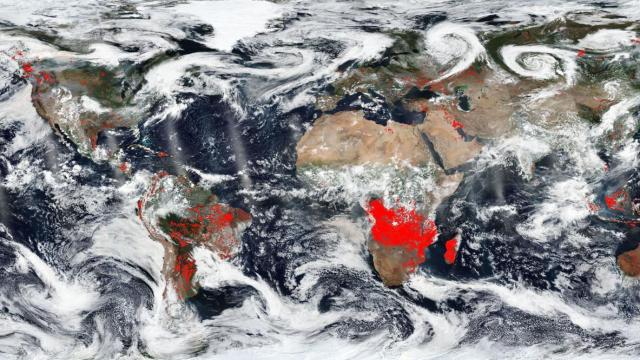A new satellite image of our planet shows fires raging across the world, from Australia to Canada to South America to Sub-Saharan Africa. But despite its striking appearance, much of this is actually quite ordinary.
The map, created by NASA, denotes fires with red dots, based on heat measurements that detect fires. While it may look as though the world is alarmingly aflame, fires occur every year. It’s the unusual intensity of fires in certain regions, linked to human-caused climate change, that we need to worry about.
Here’s the uncropped image:
“Pretty much wherever you have vegetated surface, you have fire. I don’t particularly think this is a crazy, out-of-the-ordinary year for the globe,” said Christine Wiedinmyer, associate director for science at the Cooperative Institute for Research in Environmental Sciences, a partnership between NOAA and the University of Colorado, Boulder.
But it’s a particularly big year for certain parts of the globe, she told Gizmodo. “The Western US, California and British Columbia — it’s a super big year.”
You’ll notice that many of the data points appear in Sub-Saharan Africa and Madagascar. These fires appear annually and come mostly from slash-and-burn agricultural practices common in the region. These methods clear fields and replenish the soil nutrients, but can also produce human-harming smoke. Many of the fires in Brazil and Indonesia are also due to these farming methods.
NASA has a neat tool showing how fires burn across the globe over time that you can play with here, demonstrating the annual nature of Saharan, Sub-Saharan and Indonesian fires.
But in some years, such as 2015, these practices led to forest fires that severely impacted air quality and led to a haze in the region. Studies have suggested that the El Niño weather patterns made 2015 especially bad.
This context is crucial to understanding a map like this. The fires are really bad, yes, but you need more than a map to explain why.
Take the fires in North America, as well as in many parts of South America — they are bushfires. You’ve likely heard all about the fires on the North American West Coast, many of which have been sparked by people and aggravated by the compounding effects of dry weather, winds and high heat.
A recent study demonstrated that south-central Chile is facing many of the same climate-related concerns, along with intense fires of its own.
Another huge bushfire sparked up south of Berlin, Germany just yesterday, causing evacuations. The AP reports that these fires have been complicated by buried ammunition from WWII blowing up. Germany has faced an especially hot and dry summer.
You can expect climate change to exacerbate the conditions that cause these fires in the future, especially in places where the human population is expanding.
“We know that the climate really drives fire activity severity, particularly in the western US,” Wiedinmyer said. These fires can have global impacts too, sending smoke across the ocean to Europe or up to the poles, she said.
So, you shouldn’t be surprised that there are so many fires on Earth. But you should be worried about the increase in bushfires, which we can expect will continue to worsen during our lifetimes. And you should be really worried about people who deny humanity’s very real and often dangerous impact on the environment.
[NASA]
